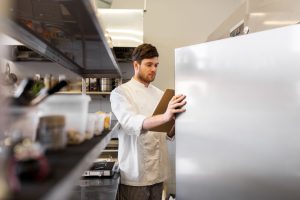Making food storage smarter and safer with IoT

Chris Potts of ANT Telecom
Storing food at the correct temperature is crucial for food companies to protect the quality and integrity of food products. Typically, food poisoning bacteria becomes inactive in the cold, and most are killed by heat. Therefore, controlling the temperature of food is a very effective way of controlling the growth of bacteria, and so reducing the risk of food poisoning.
Fridges should generally operate between 1°C to 5°C and no higher than 8°C. Naturally, freezers keep some foods for longer and so must operate below -18°C. Although, if these conditions aren’t met; because an appliance has a fault, for instance, and the food rises to a higher temperature for a sustained period of time (approx. 4 hours) then often it must be thrown away.
Therefore, to ensure food produce is safe to eat, companies must check and record the temperature of their fridges and freezers daily to ensure that they are working correctly; and that they comply with the food safety standards HACCP in particular, which is an important safety measure to meet. However, the challenge is that often this process of checking compliance is executed manually (e.g. clipboards and paper-based systems). This task is generally time consuming and an onerous burden on staff especially when you consider there are many other important activities that must be undertaken too.
Solving this productivity and HACCP compliance challenge requires a fresh approach. Particularly in an economic environment where every penny counts. Food companies cannot afford to get caught out and waste food either this is not good for people’s health, the environment, and business. Chris Potts, marketing director, ANT Telecom explains how IoT sensors enable food companies to automate processes and free up resource; while providing 100% accurate and reliable real-time data 24/7, that helps provide peace of mind, reduces costs and saves money.
Temperature monitoring
Using sensor technology is not new to the industry; but a lot of traditional sensors are hardwired into equipment, making them difficult and expensive to install. Also, cables may need to be fed through seals in fridge doors when retro-fitted. This isn’t ideal as it can leave a gap that lets cold air out and warm air in, affecting the temperature of the appliance and the contents within.
Wireless sensors are far easier to install but they require connectivity. 2G, 3G, 4G and WiFi sensors aren’t usually suitable either, as batteries don’t last long and many commercial fridges and freezers are like metal boxes that mobile signals don’t penetrate inside. The better approach is to use wireless sensors based on LoRaWAN technology. These low powered, long range sensors make them perfect for measuring fridge/freezer temperatures as data can be transmitted up to 12KM away (direct line of sight).
LoRaWAN’s long range capabilities and radio wave signals permeate through seals in the appliances too; making it possible to cover large sites with a small number of 4G/LAN gateways that upload the data to a secure online portal for management to access. Batteries can last for many years too before they need to be replaced.
Threshold breaches and data analytics

When setting up an IoT sensor system and linking it to a cloud portal system, food companies can label each sensor as they like. They can build out site maps and images to match sensors according to relevant appliances. This can provide management teams a realistic accurate map of sensors and fridges according to their operations. Since information is available online, teams can view data-led dashboards about site performance on mobile devices and laptops.
Historic information can be displayed in a chart form, showing how temperatures vary throughout the day, week and month. Attention can be drawn to anything unexpected or out of the ordinary that could affect food quality or safety. For instance, temperature monitoring thresholds can be set to notify staff if there is an issue that needs to be investigated. A team, may wish to know if a freezer drops below –18°C for more than 5 mins. Just having an awareness of this could indicate a fault with the appliance, and affect food quality and safety.
These early warning systems can help food companies to move the contents to another freezer to avoid food being thrown away unnecessarily, along with the huge expense of replacing all the contents. Furthermore, the online data collected by the sensor will provide 100% proof and peace of mind that any food moved is still safe to eat. What is more, the data that is generated and tracked can also inform fridge and equipment maintenance strategies.
Reporting for HACCP
Typically these newer and more digitally-led approaches towards temperature tracking enable teams to standardise on how data from sensors is stored within cloud systems and online portals. This means reporting formats can be set up to meet business and HACCP reporting requirements. It also means traditional paper-based record keeping and manually inputting data to generate weekly/monthly reports for auditing and compliance purposes can be replaced. These previous manual systems are often prone to human error and inaccuracies too, in comparison to today’s more modern, automated and digital systems.
Conclusion
Today, IoT sensor systems are affordable and easy to install. They’re also scalable and make it possible for teams to trial their use and start with a small number of sensors to test their effectiveness across a site. What is more, many systems can also be integrated to monitor other conditions such as power (on/off) and energy usage of appliances or even how often a fridge door is opened to assess the impact on the performance of a fridge and the affect on its contents. Monitoring for energy usage, for instance, can reduce energy bills significantly; as a poorly functioning unit can consume 100% more energy than a well maintained unit.
Manually monitoring and recording the temperature of fridges and freezers for quality, safety and compliance can be very time consuming. It isn’t always accurate and reliable. IoT monitoring solutions, using state of the art LoRaWAN sensors, are far more reliable and cost effective. Continual monitoring provides insight on how temperatures can vary and help organisations to improve food quality. And, early warning of temperature breaches helps food companies to move food fast, reducing waste and costs. Further, auto-generated reports enables food companies to fulfil compliance obligations (e.g. HACCP) efficiently.
The further, and final, question is: with all these capabilities, and the opportunity to execute accurate, cost effective and productivity enhancing processes why would food companies not want to trial these systems, digitise their processes, reduce costs, and free up resource?.
The author is Chris Potts, marketing director, ANT Telecom
Comment on this article below or via Twitter @IoTGN
